It’s no secret that hydrangeas are fan favorites among gardening enthusiasts due to their beautiful blooms. They are particularly the most sought-after flowering plant from Easter until Mother’s Day. An ideal species is the Panicle hydrangea or the Hydrangea Tree, known for its hardiness and tall height.
To care for a hydrangea tree, choose a site that allows full morning sun exposure and afternoon shade, then plant the hydrangea on well-drained soil using cuttings. Water regularly using a soaker hose or a slow drip. Apply a balanced time-release fertilizer when necessary. Repot once the plant outgrows its container.
This article discusses everything you need to know on taking care of hydrangea trees, their varieties, when to plant, how to propagate and prune, how to stimulate bloom growth, and other interesting information. Read further for more!
What Is a Hydrangea Tree?
The Panicle hydrangea is a small, woody tree native to China, Japan, and the islands of Kuril and Sakhalin. It has many varieties and cultivars that differ in growing habits, ranging from cascading to arching to erect.
This hydrangea species, when left unattended, grows as a multi-stemmed shrub but can be trained to grow as a tree with a single trunk.
- Scientific Name: Hydrangea paniculata
- Common Name: Panicle hydrangea
- Appearance: Deciduous shrub or tree with flowers that come in round, terminal, or umbrella-shaped clusters in pink, white, blue, or purple, depending on the pH level of the soil it’s planted in.
- Size: 6 to 20 feet
- Origin: Asia and America
- Indoor or Outdoor plant: Outdoor (but can also be grown indoors)
Hydrangea Tree Varieties
Limelight Hydrangea Tree
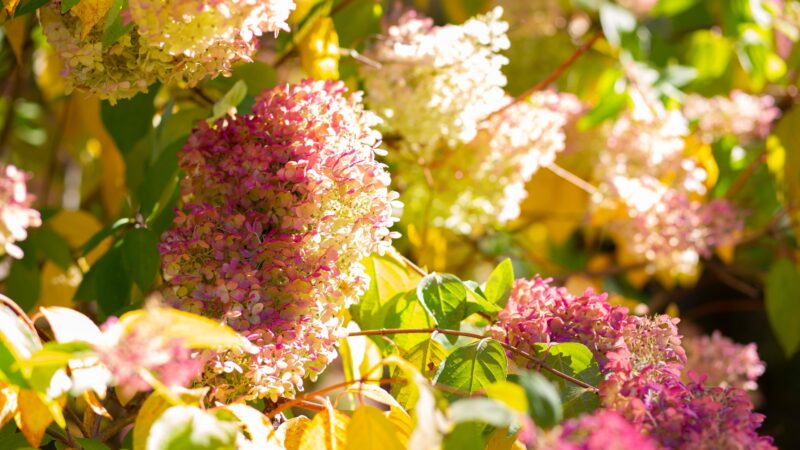
This cultivar grows unique, light chartreuse flowers that first bloom late into the summer season and then fade into a rich, deep pink color. It is usually used to make attractive dried arrangements or fresh bouquets.
Compared to most hydrangea varieties, Limelight has stronger stems that are reddish-brown in color with gray streaks.
Quick Fire Hydrangea Tree
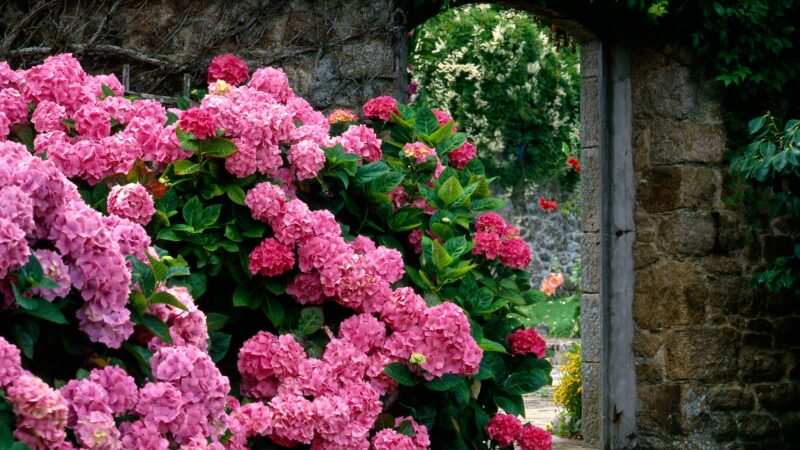
Also referred to as Hydrangea ‘Bulk,’ this variety blooms several weeks earlier than others. While other cultivars are still white, a sign that they’re still in their developing stage, the Quick Fire is already turning an attractive reddish-pink color, particularly around late July to August. It provides a nice contrast in a landscape filled with white-flowered hydrangeas.
Berry White Hydrangea Tree
The Berry White variety has long-lasting, cone-shaped flower heads that gradually turn pink and an intense raspberry red color as it matures before finally settling as wine red.
Blooming usually begins in July and lasts until September. It is ideally used for landscapes and mixed borders, as well as for fresh or dried bouquets.
Vanilla Strawberry Hydrangea Tree
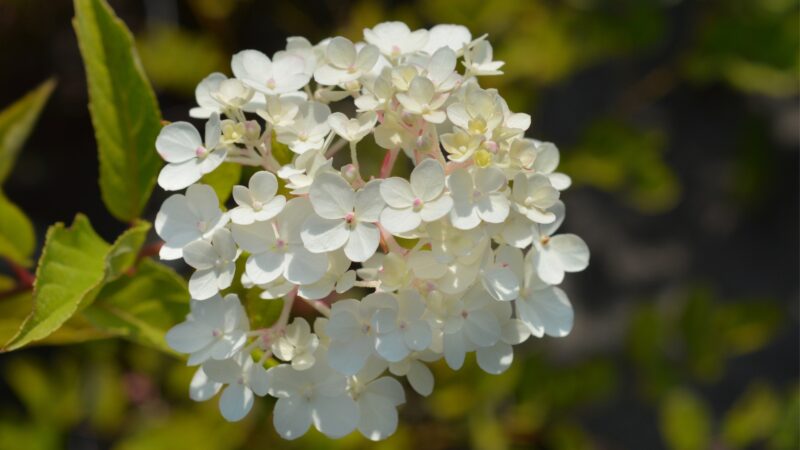
Changing from a vanilla white color to dark pink to strawberry red when it reaches maturity, the Vanilla Strawberry variety is sensitive to planting location.
When grown in fully-shaded areas, they produce sparse flowers, so make sure to plant them in partially-shaded locations. This cultivar also has relatively weak flowers, which break off early in the winter season.
Pee Gee Hydrangea Tree
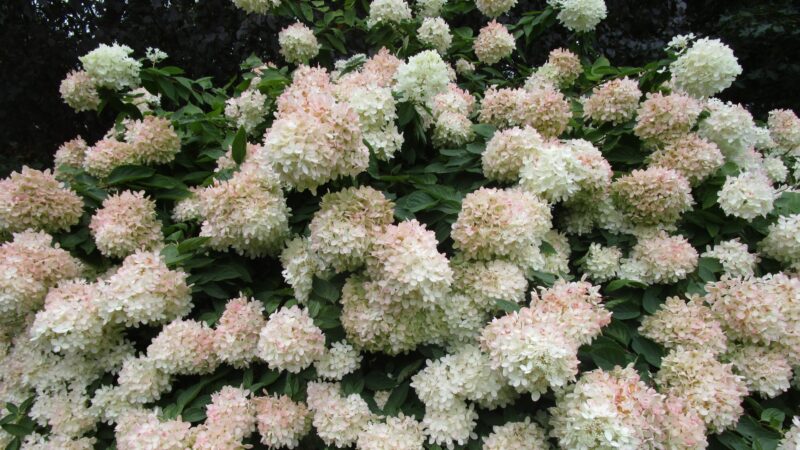
Grows large, white conical flowers that bloom from July until September and reach a pink or green color when fully mature. This cultivar is the first to be introduced from this hydrangea species.
Hence, the Panicle hydrangea is commonly referred to as the Peegee hydrangea. It is best used for courtyards, cottages, and shaded woodland gardens.
When to Plant a Hydrangea Tree?
The best time to plant is during the fall season because it gives the plant several months to develop a robust root system before its flowers bloom.
You can also plant early in the spring or even in summer, but you have to pay extra attention to how much you water the plant. When transplanting, it must be done later in the spring or fall when weather conditions aren’t too hot.
How to Plant a Hydrangea Tree?
When planting on the ground, the hole should be twice as wide as the container used for the hydrangea tree. The root ball should be placed at the same depth as the initial container.
Fill the hole with potting mix or 25 to 50 percent organic matter such as pine bark, peat moss, or compost, apply a 2 to 3-inch layer of mulch, then water.
When planting in containers, choose a sturdy one that is large enough to fit the tree and durable enough to withstand temperature changes. Use potting mix, add compost or any organic matter, then water regularly. Make sure the plant is in an area with full sunlight exposure and allow it to be shaded using a curtain.
How to Care For Hydrangea Tree?
Lighting
Compared to most hydrangea varieties that grow in shady areas, the panicle hydrangea is more tolerant to sunlight without causing any foliage fading and scorching.
It prefers morning sun exposure and afternoon shade but can achieve fuller growth with full sun exposure as long as frequent watering is observed.
Water
This plant prefers sufficient amounts of soil moisture, especially during hot weather. Use a watering bag that allows a slow drip around the plant base or a soaker hose to water deeply into the plant.
Check the root zone if it is well-irrigated by using a screwdriver to probe into the soil. Follow a partial daily water replacement irrigation schedule.
Temperature and Humidity
The Panicle hydrangea thrives in humid environments with day temperatures of 72°F and night temperatures of 65°F. It is particularly tolerant to dry climates as well as frosts since it could survive through temperatures as low as -40°F with the right protection measures. Once they reach a mature size, these plants should be moved to an open environment with good ventilation.
Soil
Despite being adaptable to any pH level, this cultivar shows a preference towards neutral to acidic, well-drained soil. It should also be rich with organic matter, peat moss, and bark as much as possible.
The soil must be tested before planting: if it holds too much water, add bark or sand, but if it drains way too quickly, add peat moss or garden mulch.
Fertilizer
A balanced time-release fertilizer applied during spring and early fall will allow optimum growth. Fertilizing is not necessary since the plant blooms better quality flowers if it is slightly starved.
However, if there are yellowing leaves, you would need to apply fast-acting fertilizer. If you desire purple or blue-colored blooms, use a fertilizer that is low in phosphate content.
Potting and Repotting
Any container can work as long as it holds soil well enough and can drain excess water. Cut its flowers to promote continuous flowering and also to maintain the overall appearance of the plant.
To repot, soak its roots with clean, chlorine-free, room temperature water, then allow it to receive air. Fill the new pot with a layer of soil, compost, vegetable film, slow-release fertilizer, and water.
Lastly, place the plant into the new pot, and you would be good to go. Repotting should be done every year or two when the plant becomes too big for its initial container.
How to Propagate a Hydrangea Tree?
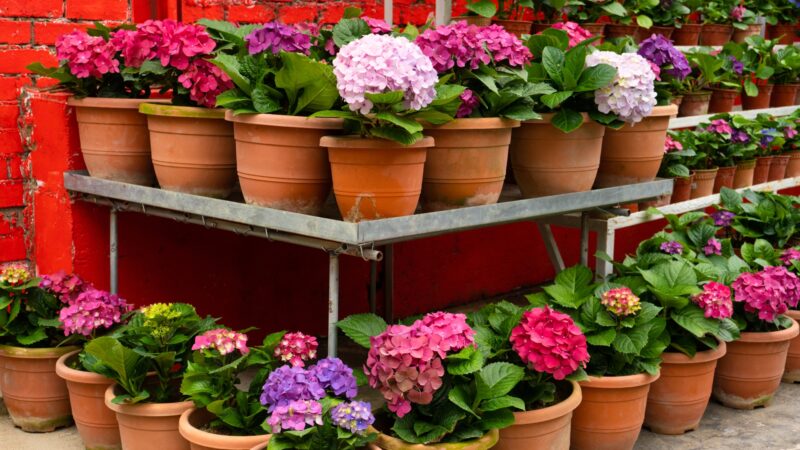
Propagation usually entails using cuttings. Softwood cuttings can be collected from June to August and then rooted by a plastic tent or under mist. Hardwood cuttings can be taken anywhere from December to February and must be treated with a rooting hormone to promote quality.
Here’s a step-by-step guide on how to root hydrangea cuttings:
- Take a 5 to 6-inch long cutting from the branch of the hydrangea tree, preferably on a branch that hasn’t flowered yet.
- Remove the leaves on the bottom two leaf nodes or the section where the leaf sprouts from the branch. Trim the largest leaves to half their size.
- This step is optional, but it provides the best results: dip the cuttings in rooting hormone, then place them inside a damp sterile or vermiculite rooting medium. Potting mix can also work if you plan to place it inside a container.
- Water the pot thoroughly then drain. The soil should be moist enough but not excessively wet.
- Cover the cuttings and the entire container with plastic. Add stakes to avoid letting the plastic touch the leaves.
- Expect roots to begin formation in 2 to 3 weeks, depending on the humidity and temperature.
Ground layering is also another method to propagate hydrangea trees, but it is not recommended since you are only able to root a small number of new plants.
How to Prune a Hydrangea Tree?
Prune in winter, in the early spring, or immediately after blooming. For hydrangea trees grown on fields, trim to within 6 inches of the ground from February to March after the initial growing season, then another time after the second growing season. For hydrangeas older than 4 years, prune about a third of older stems to the ground.
How to Get Hydrangea Tree to Bloom?
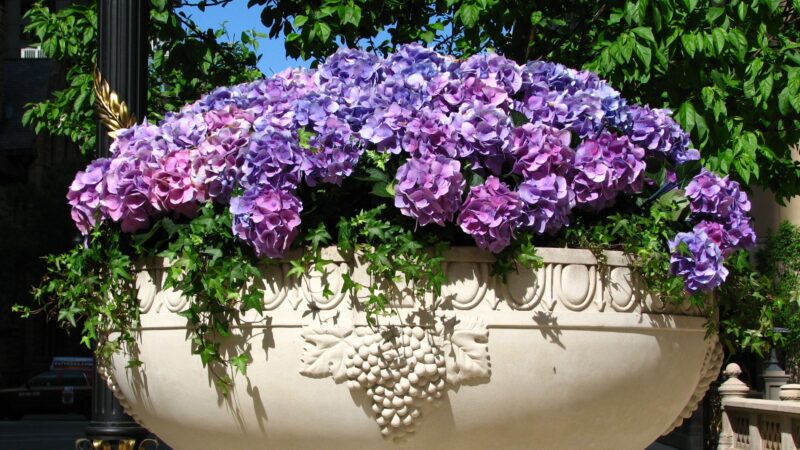
- Despite being tolerant to heat and drought, this species still needs to be regularly watered since it is sensitive to the amount of water it receives.
- Prune at the right time and make sure to trim older branches as well to help rejuvenate the plant and encourage blooms.
- Add bone meal to encourage proper blooming and flowering. Hydrangeas need phosphorus, just like many other flowering plants. Lessen the amount of nitrogen fertilizer you put in.
- Let it receive at least 4 hours of sun exposure a day.
Common Problems With Hydrangea Tree
- Lack of Blooms. This may be due to pruning at the wrong time of the year, over-pruning, over-fertilization, hungry deers that eat new flower buds, and damage from late spring and severely cold winter frosts.
- Scorched or Wilting Leaves. Late spring frosts, excessive heat stress, drought, or simply too much exposure to sunlight without adequately watering the root zone can make the leaves appear black, burnt, or brown at the margins.
- Fungal Leaf Spot. Caused by the pathogen, Cercospora hydrangea, it destroys leaves and gives gray to tan lesions ringed with dark purple. It is common in hydrangeas that were grown in crowded environments. Damage is usually not fatal.
- Cottony Camellia Scale. This is a common sucking pest that feeds on the undersides of hydrangea leaves. It releases honeydew while feeding, which grows sooty mold on the upper surface of the leaves.
- Viruses. A common pathogen is the Hydrangea ringspot virus (HRSV) which causes mottled, yellow-spotted, or dead-flecked leaves. The plant may be distorted or have fewer blooms.
Related: Hydrangea Leaves Turning Brown | 7 Causes and Its Remedies
Can Hydrangeas Trees Grow Indoors?
Hydrangeas trees may be kept indoors for several weeks, but if they become too dry, the flowers may collapse quickly, sometimes without even showing any signs of wilting.
Once the tree has finished blooming, you can either discard it, re-bloom it by cutting its shoots, repot, or plant it outdoors.
Can I Grow a Hydrangea Tree in a Pot?
You can grow a hydrangeas trees in a pot. You can even use any type of pot or container as long as it can hold soil and drain excess water properly.
Why Isn’t My Hydrangea Tree Blooming?
It may be due to pruning at the wrong time, over-pruning, over-fertilizing, deer having damaged its flower buds, or because of damage caused by frost.
List of Sources
Selecting Hydrangeas for the Home Landscape
Hydrangea Production: Species-Specific Production Guide